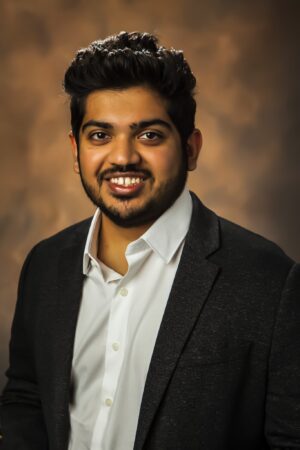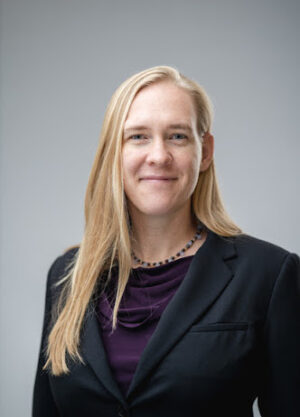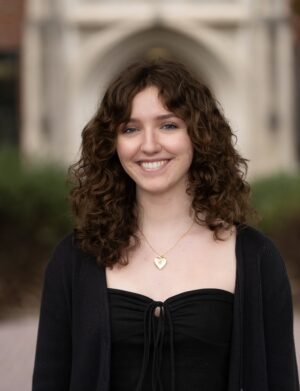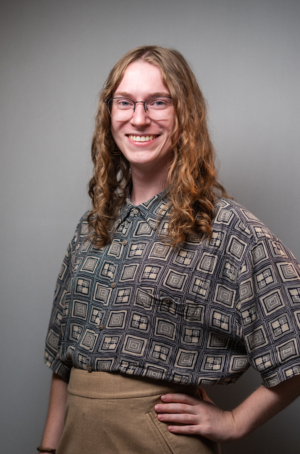On the 10-year anniversary of the first gravitational wave detection, A&S astrophysicists lead the way in discoveries
On September 14, 2015, at 4:51 a.m. Central Time, scientists witnessed something no human had ever seen before: two black holes colliding.

These black holes, which were 29 and 36 times the mass of the sun, respectively, had been circling each other for millions of years. Their rotations became increasingly faster until they eventually collided and became a single black hole.
Before, during, and after this collision, the black holes sent vibrations across the universe at the speed of light. Billions of years later, here on Earth, astronomers detected these vibrations for the first time. The first gravitational waves had been discovered.
Since then, scientists have had numerous breakthroughs that deepen our understanding of the universe, and researchers in the College of Arts and Science have been at the forefront, shaping the scientific field of black holes and gravitational waves.
While the 2015 discovery was a major “eureka” moment for astrophysicists everywhere, you may be wondering, what exactly are gravitational waves?
🛰️ A century-long endeavor
In 1915, Albert Einstein published his general theory of relativity, predicting that particularly massive objects warp the fabric of space-time.
If the universe were a rubber sheet covered in objects, then more massive objects, such as planets or stars, would bend the sheet more. Gravitational waves are produced when these objects accelerate and change the distortion of space, like ripples on a pond.
Anything with mass or energy can create a gravitational wave—even humans. Our body movements cause extremely small ripples in space-time, but these are nearly undetectable. Massive events like two black holes colliding, however, create huge ripples.
In 2015, one century after Einstein’s theory, scientists discovered physical proof that gravitational waves do exist—breaking open an entirely new field of astronomy. By analyzing these ripples in space-time, researchers could now gather information that was previously invisible to light, revolutionizing our understanding of the universe. For the first time, scientists could get closer to answering the biggest questions about our universe: What created the first structures in the universe? And how did the universe begin?
Since the first discovery ten years ago, scientists have detected gravitational waves 218 times—and A&S astrophysicists have been part of every one.
🌌 A new era of astronomy
On February 11, 2016, scientists in Washington, D.C., prepared to tell the world about the first gravitational wave detection. They were working in a large scientific collaboration, using the Laser Interferometer Gravitational-wave Observatory (LIGO), an earth-based gravitational wave detector.

More than 600 miles away in the Vanderbilt Central Library, Stevenson Chair in Physics and Astronomy Kelly Holley-Bockelmann was prepping, too.
The first gravitational-wave theorist to ever be hired at Vanderbilt, Holley-Bockelmann had heard whispers that the LIGO team was about to announce a massive discovery, so she invited the Vanderbilt community to join her in the library’s Community Room to watch the conference.
“I sat in the second row, and I watched. And I cried,” she said. “To think I was seeing a message written in spacetime that traveled a billion years to get to us—a message telling us that two black holes collided. It was so beautiful! I knew I was watching the dawn of a new era in astrophysics.”
Associate Professor of Physics and Astronomy Stephen Taylor held a similar sentiment as he watched the press conference at the California Institute of Technology, where he was a postdoctoral fellow.
For Taylor, the detection of gravitational waves not only unlocked a new world of possibilities in astrophysics, but was also confirmation that he had made the right choice to pursue his Ph.D. in the study of gravitational waves.
“I was actively discouraged from going into such a speculative area as gravitational waves—no one doubted they were real, but many doubted that we could ever detect them,” Taylor said. “I studied LIGO science for the first half of my Ph.D., developing methods to measure the expansion rate of the universe with gravitational waves that are now being used. The other half was laying the foundations for the work that my group leads at Vanderbilt. The first detection was a huge validation of my choices, and my belief that the impossible could be done with enough persistence and hard work.”
Similarly to Taylor, Assistant Professor of Physics and Astronomy Karan Jani was discouraged from pursuing his Ph.D. in the field, and he saw many astrophysicists around him lose hope that gravitational waves would ever be discovered.
Working toward his doctorate in a lab that was part of the LIGO Scientific Collaboration, Jani couldn’t believe his eyes when he learned of the first detection.
“I remember receiving an email in the early morning on September 14, 2015, saying there was something interesting that had been found. I remember thinking it was just too good to be true,” Jani reminisced. “Here I was, one of the first human beings looking at a signal that was potentially gravitational waves. You are witnessing history being made right in front of you—you are part of the story. Life changed on that Monday for me, and everything I’ve done since.”
Today, these pioneering scientists are part of a small but highly impactful team of astrophysicists who have become world-renowned leaders in gravitational wave research.
💫 Shooting for the stars
Since 2015, the College of Arts and Science’s astronomy faculty have produced groundbreaking findings and received numerous awards that place the department at the forefront of the discipline.
When Holley-Bockelmann joined Vanderbilt in 2007, she had no faculty counterparts conducting research on gravitational waves. After the first detection was announced in 2016, she had a vision to change that.
 “I mentioned in a departmental faculty meeting that we were at the dawn of a new field of gravitational wave astronomy, and that the last time physics launched a new field was a generation ago with quantum mechanics,” Holley-Bockelmann said. “I didn’t want us to miss out on the biggest thing happening in our field in a generation and would love to have other faculty to work with. Fortunately, the department shared this vision!”
“I mentioned in a departmental faculty meeting that we were at the dawn of a new field of gravitational wave astronomy, and that the last time physics launched a new field was a generation ago with quantum mechanics,” Holley-Bockelmann said. “I didn’t want us to miss out on the biggest thing happening in our field in a generation and would love to have other faculty to work with. Fortunately, the department shared this vision!”
Through the hiring of four additional scholars in the field, faculty in the Department of Physics & Astronomy now produce research on every type of black hole and are able to study the entire gravitational wave spectrum.
Holley-Bockelmann’s lab studies massive black holes at the center of galaxies to learn how they grow and evolve. Through her research, Holley-Bockelmann looks at the dynamics of black holes as they make their way to the center of a galaxy and merge. She hopes to answer how long it takes the process to happen, and the specific orbits that the black holes take along the way.
Holley-Bockelmann is currently chair of NASA’s Astrophysics Advisory Committee and served as chair of NASA‘s Laser Interferometer Space Antenna (LISA) Study Team from 2017-2024. LISA is a space-based gravitational wave detector currently under construction that will consist of three spacecraft separated by millions of miles in a triangle shape as big as the sun. It is widely believed that LISA will be the premier space-based gravity telescope of the next decade, potentially leading to an evolved theory of gravity that harmonizes gravity with quantum mechanics.
 Taylor is currently on the LISA leadership team. He is also the chair of the North American Nanohertz Observatory for Gravitational Waves (NANOGrav) Collaboration. This international team of scientists uses the precise timing of pulsars, which are ultra-dense stars, to detect low-frequency gravitational waves. By observing a network of pulsars the size of the Milky Way galaxy, NANOGrav creates a pulsar timing array to hear the subtle hum of gravitational waves created by supermassive black holes that are billions of times bigger than the Sun—the pioneering discovery that Taylor announced in 2023, and for which he was awarded the Kavli Plenary Lectureship by the American Astronomical Society, the Eddington Lectureship by the Royal Astronomical Society and Cambridge University, and the Frontiers of Science Award in Theoretical Physics by the International Congress of Basic Science.
Taylor is currently on the LISA leadership team. He is also the chair of the North American Nanohertz Observatory for Gravitational Waves (NANOGrav) Collaboration. This international team of scientists uses the precise timing of pulsars, which are ultra-dense stars, to detect low-frequency gravitational waves. By observing a network of pulsars the size of the Milky Way galaxy, NANOGrav creates a pulsar timing array to hear the subtle hum of gravitational waves created by supermassive black holes that are billions of times bigger than the Sun—the pioneering discovery that Taylor announced in 2023, and for which he was awarded the Kavli Plenary Lectureship by the American Astronomical Society, the Eddington Lectureship by the Royal Astronomical Society and Cambridge University, and the Frontiers of Science Award in Theoretical Physics by the International Congress of Basic Science.
Taylor hopes his research will reveal the origins of the largest black holes, find flaws in Einstein’s theory, and paint a more unified portrait of astronomical systems.
 Jani uses LIGO, the earth-based gravitational wave detector, to study black holes, and specifically to find intermediate-mass black holes. Jani announced the first confirmed discovery of an intermediate-mass black hole in 2020, and earlier this year, Jani’s research team discovered new evidence of even heavier intermediate-mass black holes. For his work, Jani was a co-recipient of the Special Breakthrough Prize in Fundamental Physics and featured in Forbes’s 30 Under 30 list. Moving forward, Jani hopes to learn what created the first galaxies, why the universe is expanding rapidly and at an accelerated rate, and how the universe began.
Jani uses LIGO, the earth-based gravitational wave detector, to study black holes, and specifically to find intermediate-mass black holes. Jani announced the first confirmed discovery of an intermediate-mass black hole in 2020, and earlier this year, Jani’s research team discovered new evidence of even heavier intermediate-mass black holes. For his work, Jani was a co-recipient of the Special Breakthrough Prize in Fundamental Physics and featured in Forbes’s 30 Under 30 list. Moving forward, Jani hopes to learn what created the first galaxies, why the universe is expanding rapidly and at an accelerated rate, and how the universe began.
Assistant Professor of Physics and Astronomy Jessie Runnoe uses light to understand how supermassive black holes grow. Traditionally, black holes grow by consuming gas, which produces a huge beacon of light called a quasar. Runnoe utilizes telescopes, such as the Hubble Space Telescope and the James Webb Space Telescope which award observation time through a highly-competitive process, to see this light and find the black holes. With the discovery of gravitational waves, she now has a clearer beacon for where exactly a black hole is located before using a telescope. Runnoe is also a leader of the Sloan Digital Sky Survey Time Domain Working Group, a collaboration of scientists studying how celestial bodies change over time.
and the James Webb Space Telescope which award observation time through a highly-competitive process, to see this light and find the black holes. With the discovery of gravitational waves, she now has a clearer beacon for where exactly a black hole is located before using a telescope. Runnoe is also a leader of the Sloan Digital Sky Survey Time Domain Working Group, a collaboration of scientists studying how celestial bodies change over time.
“I think about the most massive black holes in the universe, and these live in the centers of galaxies, including ours,” Runnoe said. “We think every galaxy has a black hole, so it seems inevitable that if you take two galaxies and smash them together, you’d have two black holes orbiting each other. But we’ve never seen one.”
 While Runnoe is searching for supermassive black holes in regular galaxies, Assistant Professor of Physics and Astronomy Mallory Molina is looking for intermediate-mass black holes in dwarf galaxies. Molina developed a new observational technique to accomplish this that uses traditional telescopes as well as large surveys to grasp how these black holes affect the growth and evolution of their host galaxy. This knowledge will give scientists a better understanding of galaxy evolution as a whole, as well as initial black hole formation. Molina was previously a Ford Postdoctoral fellow and the first Eccles AstroData Postdoctoral fellow, as well as the co-founder of the organization Towards a More Inclusive Astronomy, which aims to support astronomy scholars who are underrepresented or lack resources.
While Runnoe is searching for supermassive black holes in regular galaxies, Assistant Professor of Physics and Astronomy Mallory Molina is looking for intermediate-mass black holes in dwarf galaxies. Molina developed a new observational technique to accomplish this that uses traditional telescopes as well as large surveys to grasp how these black holes affect the growth and evolution of their host galaxy. This knowledge will give scientists a better understanding of galaxy evolution as a whole, as well as initial black hole formation. Molina was previously a Ford Postdoctoral fellow and the first Eccles AstroData Postdoctoral fellow, as well as the co-founder of the organization Towards a More Inclusive Astronomy, which aims to support astronomy scholars who are underrepresented or lack resources.
“Given that dwarf galaxies have not significantly evolved over the course of the universe, the black holes they host retain some memory of their initial formation,” Molina said. “This means that by understanding the underlying population of massive black holes in dwarf galaxies, we can better understand how the first generation of black holes formed.”
 To get the full picture of black holes, Assistant Professor of Physics and Astronomy Alex Lupsasca’s research focuses on images, which are produced from observations of black holes via electromagnetic waves, to more sharply probe their strong gravity. He is working toward this goal as part of a Simons Foundation collaboration. Lupsasca compares gravitational wave data with his images of black holes to gain new information.
To get the full picture of black holes, Assistant Professor of Physics and Astronomy Alex Lupsasca’s research focuses on images, which are produced from observations of black holes via electromagnetic waves, to more sharply probe their strong gravity. He is working toward this goal as part of a Simons Foundation collaboration. Lupsasca compares gravitational wave data with his images of black holes to gain new information.
“Black holes are the most mysterious objects in the universe, and a complete theory of quantum gravity will likely be necessary to understand them,” Lupsasca said. “Black holes are likely the key to unlocking the next deeper layer of fundamental theory.”
☄️ The wave of the future
As this trailblazing team of Vanderbilt astrophysicists works to enhance our understanding of the creation of the universe, they are also training future scientists to push forward with new exploration and discoveries.
They have created important academic programming to support promising individuals with a passion for science, including the nation’s first graduate certificate in multimessenger astronomy, Establishing Multimessenger astronomy Interdisciplinary Training, founded by Holley-Bockelmann, and the Fisk-Vanderbilt Master’s-to-Ph.D. Bridge Program, co-led by Holley-Bockelmann.
 Ph.D. student Jaelyn Roth was drawn to Vanderbilt by the array of black hole and gravitational wave research that the department offered. Working alongside Holley-Bockelmann, she spends her days studying the interactions between massive black holes and their host galaxies.
Ph.D. student Jaelyn Roth was drawn to Vanderbilt by the array of black hole and gravitational wave research that the department offered. Working alongside Holley-Bockelmann, she spends her days studying the interactions between massive black holes and their host galaxies.
“When I began research during my undergraduate career, I finally saw a path where I could be curious, ask big questions, and contribute to humanity’s collective understanding of our universe,” Roth said. “We still don’t understand how supermassive black holes could have gotten so massive within the age of the universe. One theory is the merging of many smaller black holes. We can make predictions about the rate these mergers happen given the number of gravitational wave events we detect on Earth and narrow in on the mechanism(s) that give supermassive black holes their immense masses.”
 Ryan Nowicki is working alongside Jani to understand how black holes spin and what their spins can tell us about the black holes’ evolutionary history.
Ryan Nowicki is working alongside Jani to understand how black holes spin and what their spins can tell us about the black holes’ evolutionary history.
“I remember I was a freshman in high school when LIGO announced that they had made their first detection of gravitational waves,” the Ph.D. student said. “I chose Vanderbilt because the physics and astronomy department has a big focus on gravitational waves and multi-messenger astronomy. The expertise gathered here at Vanderbilt in such a niche area has cultivated a collaborative atmosphere, which I knew would be great for me, both as a student and as a budding researcher.”
🚀 To infinity and beyond
The universe is expanding rapidly, and so is the field of astronomy.
Holley-Bockelmann, Taylor, and Jani were all discouraged from pursuing studies in the field of gravitational waves. Today, the department receives at least one email every week from a student interested in pursuing a Ph.D. on the subject.
Along with this influx of young scientists in the field, innovative projects are on the horizon. New astronomy instruments, such as the Dark Energy Spectroscopic Instrument and the Vera C. Rubin Observatory, will soon drive discoveries for dwarf galaxies and advance our understanding of galaxy evolution.
“We are entering a golden age of dwarf galaxy science,” Molina said. “We will finally be able to answer simple fundamental questions like, ‘How many dwarf galaxies host black holes? And how do these black holes impact their host galaxy?’”
In 2028, NANOGrav, led by Taylor, is expected to complete construction on a new array of radio dishes in Nevada called the Deep Synoptic Array, growing pulsar timing arrays to double or triple the current size across the galaxy.
In 2031, the Black Hole Explorer (BHEX), for which Lupsasca is a project scientist and has won a 2024 New Horizons in Physics Prize, will launch a satellite into Earth’s orbit that will take the highest resolution photos of black holes in the history of astronomy.
In 2035, LISA is scheduled to launch and will detect gravitational waves in lower frequencies than LIGO, allowing scientists to study waves generated by many different types of events, not just black hole mergers.
The Vanderbilt Lunar Labs Initiative, directed by Jani, is building the Laser Interferometer Lunar Antenna (LILA), a gravitational wave detector on the moon. LILA aims to open another doorway to the universe by making the first-ever measurement of gravitational waves in the sub-Hertz frequencies. Using LILA, scientists expect to be able to “hear” the first sound the universe ever made.
“I think it’s extraordinary that a relatively new, and still quite primitive species like us, on our tiny planet, in our run-of-the-mill solar system, in a pretty mediocre galaxy, have looked up and asked such deep questions about the universe,” Taylor said. “Even more extraordinary is that we have understood any of what is going on. The vastness of the universe is mind-boggling; if you think too hard about it, you might feel like we’re insignificant here. But I think that makes what we have here on Earth all the more special.”
🪐 Why do you study the universe? 🪐
- Kelly Holley-Bockelmann: “I love that there’s so much we don’t know! I love it when we make a discovery that we never expected and that changes what we thought we knew. If you asked an astronomer in 2014 the mass of a stellar black hole, they would say very confidently that it’s 10 solar masses. Period. The next year, LIGO observed 30 solar mass black holes, which sent astronomers back to the drawing board to figure out how you can get such big black holes from stars.”
- Alex Lupsasca: “The universe is an unending source of mystery, and physics is full of surprises: its history shows us that truth is always stranger than fiction. There are always new dazzling discoveries waiting around the corner!”
- Mallory Molina: “There are so many galaxies with so many different formation histories and current on-going activity—yet they all originated from the same event: the Big Bang. Learning how they evolved over time to become what they are is one of the most exciting mysteries of our time.”
- Jaelyn Roth: “I am amazed by the leaps and bounds that humans have made in our understanding of the universe, and I am equally mystified by just how much we still have left to understand.”
